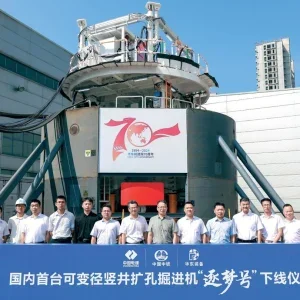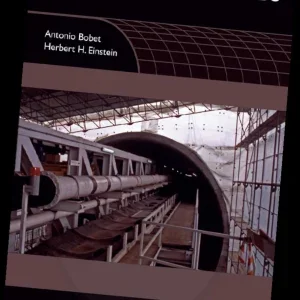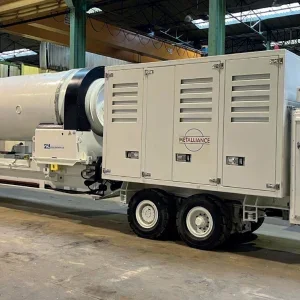The use of steel fibre reinforced concrete (SFRC) for underground applications now has a history of over three decades in sprayed concretes and over two decades in segmental tunnel linings.
As growth of the use of SFRC in sprayed concretes developed in the underground sector, several manufacturers entered the market, presenting designers with an array of steel fibres from which to choose. Early specifications for steel fibre reinforcement were often very basic and prescriptive, merely asking for a set dosage rate per m3 of concrete, ignoring factors such as rebound characteristics, tensile strength and aspect ratio.
Over the years, as more knowledge was gained about the behaviour of steel fibres in concrete, performance specifications became more prevalent and new test methods were developed to monitor and measure this. By the end of the 1990’s, it was becoming easier for designers to confidently specify steel fibres for use in both sprayed concretes and segmental linings.
However, during the same period, a range of synthetic fibres entered the underground construction market giving designers yet more choice. These included micro and macro-synthetic fibres, which were generally manufactured from polyolefin and polypropylene.
The polypropylene versions were used to improve the performance of concrete in fires by significantly reducing spalling and the polyolefin fibres favoured for structural performance, in competition with steel fibres.
The result is that today we have a fair degree of confusion in the market as to which generic type of fibre a designer should select. Each fibre type has its own characteristics and suitable applications but this piece concentrates on their use for structural purposes in sprayed and pre-cast concrete linings for underground civil engineering structures such as tunnels and caverns.
The main parameters of fibre reinforced concrete (FRC) that are pertinent to tunnel lining design are the bending moment capacity, indirect tensile strength, flexural (and residual flexural) strength and ductility (or toughness) values.
Over the years, many test methods have been developed to measure and determine the performance of FRC. These include beam tests, square and round panel tests and, more recently, the double punch (or Barcelona) test. The common factor in each of these tests is the measurement of the ability of FRC to continue to support and carry load after the concrete matrix has cracked. This is, in effect, the essence of the structural performance of FRC.
After first crack of the concrete matrix, the tensile forces are redistributed to the fibres bridging the crack. If the FRC continues to carry load as further cracks are propagated and deformation takes place, then it is easy to understand that creep of the fibres is a very important parameter.
Macro-synthetic fibres versus steel fibres
There are a large number of macro synthetic fibres available in the market, made from a variety of organic polymers and with differing geometries. The elastic modulus of steel is approximately 200 GPa, whereas that of macro-synthetic fibres is generally between 2 and 10 GPa. As well as requiring more strain to achieve a similar level of stress, macro synthetic fibres, like concrete, exhibit inherently elasto-plastic behaviour under load so it is therefore quite simple to conclude that macro-synthetic fibres will exhibit higher creep characteristics than steel fibres under sustained load.
Due to the significantly lower stiffness of synthetic fibres versus steel, it is inevitable that crack widths in synthetic FRC will be greater than those in steel FRC, given that loads and conditions are equal.
In underground civil engineering structures it is highly desirable to keep lining deflections and, consequently, crack widths to an absolute minimum. In mining support applications, where very high deflections (and crack widths) are acceptable and anticipated, then macro- synthetic fibres can be used and may well have a benefit over steel fibres in sprayed concrete. Such fibres have been used extensively in the deep level mines of Australia and South Africa.
In 2000, Stefan Bernard, the developer of the round panel test for FRC, suggested that “steel would be the material of choice for applications requiring small maximum crack widths, with synthetic fibres becoming more attractive for high levels of deformation”.
Admittedly, synthetic fibres may have improved their performance since then, but more recent comparative beam toughness tests for segmental linings by R Ratcliffe of the Australian Tunneling Society, demonstrate that even high dosages of macro-synthetic fibres have toughness levels at low deflections that are inferior to moderate dosages of steel fibres (Fig 2).
The curves in Fig 2 indicate a strain hardening characteristic of steel fibres at low deflections, whereas the macro synthetic fibres exhibit strain softening. This means that once the concrete matrix has cracked, tensile loads are redistributed and taken up by steel fibres more quickly than by macro-synthetics, thus providing greater toughness at the level of crack widths required for civil engineering structures. It is only when macro-synthetic fibres are used at very high (often greater than those quoted in manufacturers’ literature) dosage rates that strain hardening can be achieved.
Currently, the specified test of choice for sprayed FRC in civil engineering structures is the plate test according to European Standard EN 14487-1, Sprayed Concrete, Definition, Specification and Conformity”. The energy absorption value measured for a panel can be adopted when, in the case of ground support, emphasis is placed on the energy which has to be absorbed during the deformation of the ground. This is especially useful for primary sprayed concrete linings.
The round determinate panel test, ASTM C1550-08, which measures the residual strength for deflections up to 40mm has been promoted by the macro-synthetic fibre industry. However, selection of the most appropriate central deflection to specify depends upon the intended application for the material. The energy absorbed up to 5mm central deflection is applicable to situations in which the material is required to hold cracks tightly closed at low levels of deformation. Examples include final linings in underground civil structures such as railway tunnels that may be required to remain watertight. The residual strength up to 40mm deflection is, in fact, only applicable to situations where the material is expected to suffer very severe deformation in situ (which means a very wide crack). Generally speaking this test should not be used for civil engineering structures with more than 10mm anticipated deflection.
The round panel test is an isostatic one, it should not be used to make a correlation with the EN hyper static square panel test. A hyper static test is an indeterminate, multi-crack process test whereas an isostatic test is a determinate process with pre-determined crack patterns. Because of this difference, it is not possible nor makes sense to try to compare the results of theses two tests.
When it comes to waterproofing membrane systems some information from the macro-synthetic fibre industry has intimated a serious concern about the danger of steel fibres producing from sprayed concrete surfaces and puncturing through previously, or subsequently, installed waterproof membranes. However, the practical experience on many sites and test results from independent laboratories confirm clearly that there are no problems with the membrane/protection sheets in combination with steel fibre reinforced sprayed concrete.
Performance in tunnel fires
In recent years, the occurrence of major fires in tunnels has created a much needed emphasis on safety and the need to mitigate potential structural damage in tunnels. During the design phase of the Channel Tunnel Rail Link (CTRL) London tunnels, extensive fire tests on tunnel segments under loaded conditions were conducted by CTRL at the University of Delft in the Nertherlands.
The tests proved that the inclusion of 1 kg/m3 of synthetic monofilament fibres to the SFRC matrix significantly reduced the depth of spalling in the segments. This is due to the fact that the fibres melt and provide additional space and routes to their interfacial zones for the vapour pressure in the concrete to dissipate and hence reduce the amount of spalling.
As a consequence of the test results, polypropylene monofilament fibres of 18microns diameter and 12mm length were incorporated in the SFRC segments for the entire length of tunnels in the CTRL project.
More recent developments in monofilament fibre technology and fire test results indicate that fibres with a diameter <20 microns diameter and of 6mm length should be recommended for optimum resistance to spalling in fires. It should be noted here that micro-synthetic fibres do not give any additional structural capacity to concrete. It should also be noted that, contrary to some supplier literature, macro synthetic fibres have no significant effect on spalling.
Fires in tunnels can reach high temperatures of up to 1400°C as shown in Fig 3. The melting point of synthetic fibres is generally between 150 to 180°C, which is beneficial in the case of micro-synthetic fibres for spalling resistance.
In the case of macro-synthetic fibres subjected to fire, however, the situation, in terms of their structural load carrying capacity is more alarming and here it is worth quoting directly Clause 5.1.5 of Concrete Society technical report number 65 (2007): “When subjected to fire, macro fibres will soften as the temperature rises and will melt at a temperature of 150-160°C. They will lose their mechanical properties and will no longer provide any structural capacity. Clearly, therefore, it is important to avoid the use of macro synthetic fibres to provide structural capacity which may be lost in the event of a fire with consequent collapse. Even where used for non-critical purposes, it may be necessary to remove and replace the affected concrete after a fire. In some situations the use of passive fire protection to limit the temperature rise in the concrete may be necessary.”
Steel fibres do not start to melt until approximately 1130°C and consequently, at high temperatures, have more capacity to hold a FRC composite together than macro-synthetic fibres.
Fig 4 (6) shows the typical temperature profiles within concrete sections that are subjected to fire (e.g. sprayed concrete or segmental final linings). From looking at the graph, it is easy to estimate that after approximately one hour exposure to a tunnel fire, synthetic macro-fibres within the first 100mm of concrete will have melted and lost their structural capacity.
Fire resistance tests on SFRC segments have recently been conducted in Europe. They showed that metallic fibres are an improvement over traditional steel reinforced concrete, which, due to the thermal conductivity of the rebar, causes rapid bursting and spalling of the exposed concrete.
Spalling, although unavoidable, is limited in steel fibre concrete when compared to ordinary reinforced concrete.
As with conventionally reinforced concrete segments, the addition of polypropylene monofilament fibres to the composition of the SFRC considerably reduces the risk of spalling.
Therefore a combination of metallic fibres and polypropylene monofilament fibres constitutes an optimum solution for the improved fire resistance of pre-cast, insitu and sprayed concrete final linings in underground structures.(7)
Summary
Although macro-synthetic fibres may have a place, on occasions, in sprayed concrete support for some mining applications, uncertainty remains over their suitability for application in both sprayed concrete and segmental final linings for civil engineering structures.
The major concerns that designers need to consider when specifying a generic fibre type for final lining applications are anticipated convergence/deflections; long term creep characteristics of the fibre type after cracking of the concrete matrix and performance in fire.
In addition, more practical matters, such as the effect of the fibre type on the plastic properties of the concrete should also be taken into account.
The performance of fibre reinforced concrete increases with the performance of the concrete matrix; the volume of fibres in the mix and the intrinsic performance of the fibre in the matrix (geometry, aspect ratio (l/d), method of anchoring, tensile strength, E modulus etc).
Therefore clear test procedures and performance criteria of the FRC should be specified for each project.
Fig 1 – Long Term Creep Macro synth 2 4.55kg/m3 (deflection in 1/100 mm) versus time (days) [Lambrechts 2005] Fig 2 – Comparative beam toughness tests [Ratcliffe] Fig 3 – Fire temperature curves Fig 4 – Typical temperature profiles with concrete sections subjected to fire






